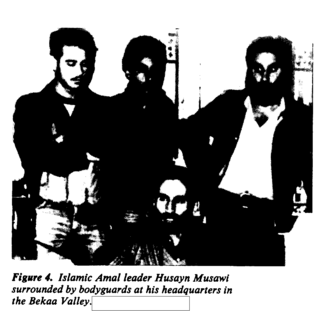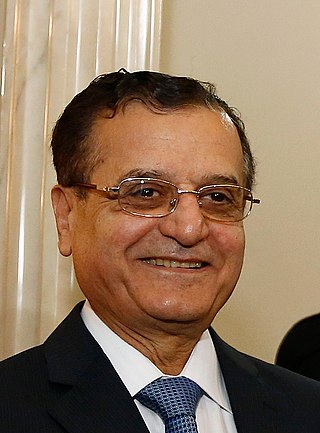
Hassan Nasrallah (Arabic: حسن نصر الله [ħasan nasˤrɑɫɫɑh]; born 31 August 1960) is a Lebanese cleric and political leader who has served as the 3rd secretary-general of Hezbollah since his predecessor, Abbas al-Musawi, was assassinated by the Israel Defense Forces in February 1992.
The Islamic Jihad Organization – IJO or Organisation du Jihad Islamique (OJI) in French, but best known as "Islamic Jihad" for short, was a Shia militia known for its activities in the 1980s during the Lebanese Civil War. According to investigative journalist Ronen Bergman, "Islamic Jihad" was one of many aliases used by Hezbollah. They demanded the departure of all Americans from Lebanon and took responsibility for a number of kidnappings, assassinations, and bombings of embassies and peacekeeping troops which killed several hundred people. Their deadliest attacks were in 1983, when they carried out the bombing of the barracks of French and U.S. MNF peacekeeping troops, and that of the United States embassy in Beirut.

Trans World Airlines Flight 847 was a flight from Cairo to San Diego with en route stops in Athens, Rome, Boston, and Los Angeles. On the morning of June 14, 1985, Flight 847 was hijacked shortly after take off from Athens. The hijackers demanded the release of 700 Shia Muslims from Israeli custody and took the plane repeatedly to Beirut and Algiers. Later Western analysis considered them members of the Hezbollah group, an allegation Hezbollah rejects.

The Amal Movement is a Lebanese political party and former militia affiliated with the Shia community. Founded by Musa Al-Sadr and Hussein el Husseini in 1974, the party has been led by Nabih Berri since 1980.
The War of the Camps, was a subconflict within the 1984–1990 phase of the Lebanese Civil War, in which the Palestinian refugee camps in Beirut were besieged by the Shia Amal militia.

Musa Sadr al-Din al-Sadr was an Iranian-born Lebanese scholar and political leader who founded the Amal Movement.

Husayn Al-Musawi is a Lebanese who founded the now-dissolved pro-Iranian Islamist militia Islamic Amal in 1982. He was a Shia from Baalbek.

Abd al-Husayn Sharaf al-Din al-Musawi, also commonly spelled Abdel Hussein Charafeddine, Sharafeddine, or Sharafeddin, was a Shi'a Twelver Islamic scholar who has widely been considered a social reformer, "activist", and modern founder of the city of Tyre in Southern Lebanon.

Subhi al-Tufayli was the first Secretary-General or leader of Hezbollah for a year. Al-Tufayli is a Shia Islamist, but is a very vocal critic of Iran and the current Hezbollah leadership. He has been an active member of the Lebanese movement Amal Movement, and maintains his support of the organization.
The Lebanon hostage crisis was the kidnapping in Lebanon of 104 foreign hostages between 1982 and 1992, when the Lebanese Civil War was at its height. The hostages were mostly Americans and Western Europeans, but 21 national origins were represented. At least eight hostages died in captivity; some were murdered, while others died from lack of adequate medical attention to illnesses. During the fifteen years of the Lebanese civil war an estimated 17,000 people disappeared after being abducted.

Lebanese Shia Muslims, historically known as matāwila (Arabic: متاولة, plural of متوال mutawālin refers to Lebanese people who are adherents of the Shia branch of Islam in Lebanon, which plays a major role along Lebanon's main Sunni, Maronite and Druze sects. According to the CIA World Factbook, Shia Muslims constituted an estimated 31% of Lebanon's population in 2022.

The Lebanese Resistance Regiments (Arabic: أفواج المقاومة اللبنانية | ʾAfwāj al-Muqāwama al-Lubnāniyya, أَمَل ʾAMAL), also designated Lebanese Resistance Battalions, Lebanese Resistance Detachments, Lebanese Resistance Legions and Battalions de la Resistance Libanaise (BRL) or Légions de la Resistance Libanaise (LRL) in French, but simply known by its Arabic acronym أَمَل ʾAmal which means "Hope", were the military wing of the Movement of the Dispossessed or Movement of the Deprived, a political organization representing the Muslim Shia community of Lebanon. The movement's political wing was officially founded in February 1973 from a previous organization bearing the same name and its military wing was formed in January 1975. The Amal militia was a major player in the Lebanese Civil War from 1975 to 1991. The militia has now been disarmed, though the movement itself, now known as the Amal Movement (Arabic: Harakat Amal), is a notable Shia political party in Lebanon.

Adnan Mansour is a Lebanese diplomat, politician and the former minister of foreign affairs and emigrants.
The Lebanese–Syrian border clashes were a series of clashes on the Lebanon–Syria border caused by the ongoing Syrian Civil War.
On 15 August 2013, a car bomb exploded in Beirut, Lebanon killing 27 people and injuring over 200 people. The car bomb was intended for the stronghold of Hezbollah. It was reportedly the "worst explosion in south Beirut" since a 1985 truck bomb assassination attempt targeting top Shiite cleric Mohammed Hussein Fadlallah. The Islamist group Aisha Umm-al Mouemeneen, also known as Brigades of Aisha, were responsible for the explosion. In their statement the group accused Hezbollah of being Iranian agents and threatened more attacks. "This is the second time that we decide the time and place of the battle ... And you will see more, God willing," However Interior Minister Marwan Charbel and other politicians blamed Israel for the attack.
From its inception, the Syrian Civil War has produced and inspired a great deal of strife and unrest in the nation of Lebanon. Prior to the Battle of Arsal in August 2014, the Lebanese Army has tried to keep out of it and the violence has been mostly between various factions within the country and overt Syrian involvement has been limited to airstrikes and occasional accidental incursions.
The following lists some remarkable events that happened in 2014 in Lebanon on a monthly basis.
The War of Brothers was a period of violent armed clashes between rivals Amal and Hezbollah, Lebanon's main Shiite militia movements, during the final stages of the Lebanese Civil War. The fighting broke out in April 1988 and proceeded intermittently in three phases over the following years until the signing of an agreement brokered by their respective foreign backers, Syria and Iran, in November 1990.
Sayed Jafar Sharafeddin – also transliterated from the Arabic language as Ja'far or Jaafar and Charafeddine, Sharafeddine, Sharaf al-Din or Sharf al-Din respectively – was a Baathist politician, who served as a deputy (member) of the Lebanese parliament.









